Dave Craw, Joanna Druzbicka, Shanna Law, Kat Lilly, and Cathy Rufaut
Inland salt accumulations
New Zealand generally has a temperate maritime climate, with frequent rain events that occur throughout the year. The rain contains small amounts of salts derived from the surrounding ocean, as aerosols in sea spray. Most of these salts are readily washed away into groundwater and streams after rain deposition. Consequently, evaporative salt accumulations are rarer in the New Zealand environment than in many continental areas around the world. However, inland parts of Otago, and the area called Central Otago in particular, is relatively arid (rainfall as low as 300 mm/year) and has very hot summers. In addition, the area is commonly buffeted by warm dry winds from the northwest (see rainfall map below). This combination of high temperatures, low rainfall, and wind-driven evaporation has resulted in localised accumulation of evaporative salts. One example is the Sutton Salt Lake , the only inland salt lake in New Zealand (Sutton Salt Lake Scenic Reserve (DOC Website)). However, salt-rich soils and rock surfaces are widespread as well, and there are some well-preserved examples as indicated on the Central Otago map below. Agricultural development of the area is progressively modifying these salt-rich areas, so some have been placed into reserves for long-term preservation of these unusual substrates and the distinctive ecosystems that have developed on them (Salt Pans on NZ plant conservation network website).
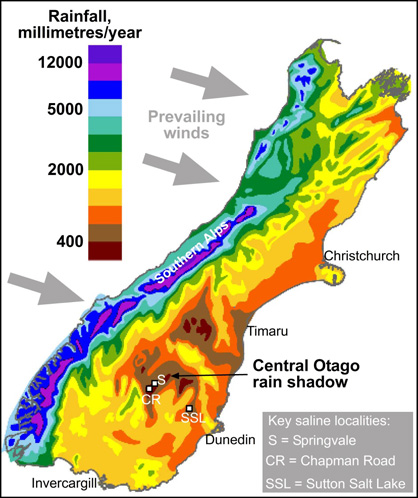
Rainfall map of the South Island, based on NIWA data. Formation of the Central Otago rain shadow occurs in the lee of the Southern Alps mountains, which protect the area from prevailing moisture-bearing westerly winds. Rain that does reach the rain shadow area contains minute aerosols of sea water gathered over the surrounding ocean. The high evaporation rates in the rain shadow cause these salts to stay behind when rain water lying on the surface is evaporated back into the atmosphere.
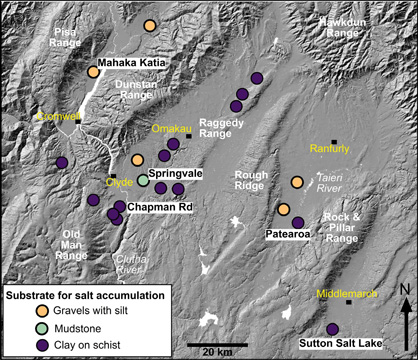
Topographic image of Central Otago, showing some of the principal localities for remnants of saline substrates. The impermeable substrates on which salts accumulated are indicated with different colours. Named sites are significant reserves for salt-tolerant plants that are administered by Department of Conservation.
Geological controls on salt accumulation
Salts can accumulate only if the rainwater in which they arrive can pool on the surface. This allows the water to evaporate, leaving the salts behind. Most of the rocks and soils of Central Otago are sufficiently permeable that rainwater infiltrates into the rock mass and joins the groundwater at depth, taking the dissolved salts along. This applies even to the schist basement, which is cut by numerous fractures that allow incoming rain water to penetrate below the surface. However, some rocks are sufficiently impermeable to prevent this downward percolation of water, and the rain is trapped at the surface, where it evaporates. Hence, the saline areas of Central Otago occur on a predictable range of substrates, as in the map above and the sketches below.
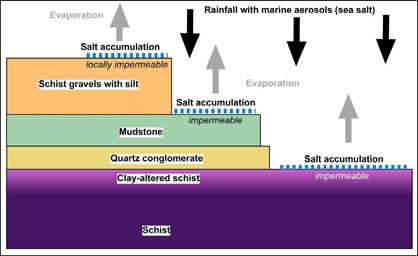
Generalised geological controls on saline substrates in Central Otago. Salts accumulate on impermeable substrates exposed at the surface by natural or anthropogenic erosion. The most widespread feature is the clay-rich alteration zone on the schist basement (typically the Waipounamu Erosion Surface). Quartz conglomerates (40-20 million years old) are generally too permeable for salt accumulation. Likewise, most of the surficial gravels (10,000 to 5 million years old) are too permeable unless impermeable silt-rich zones occur near the surface.
A range of these different rock types is exposed by natural uplift and erosion along the margins of many of the schist ridges of Central Otago (see cross section below). The ridges are actively rising, causing tilting and erosion of the sediments and the underlying schist. This uplift is part of the regional tectonic deformation associated with modern plate tectonic motion in the South Island and uplift is occurring at rates of about 0.1 mm/year. Hence, the salt accumulation areas that arise because of the natural uplift are temporary on time scales of hundreds to thousands of years. As uplift progresses, the salt accumulation environments become eroded and the salts are lost to streams and groundwater. New salt accumulation environments are also constantly being unroofed by uplift and erosion elsewhere along the ridge margins.
- Patearoa gold: Alluvial concentrations in a dynamic environment
- Rise of modern mountains on Otago's northeast margin
The most widespread impermeable substrate is a zone of clay-rich rock that occurs at the boundary between the schist bedrock and the overlying sediments over most of east and Central Otago. This zone is formed by groundwater alteration of the schist bedrock, and the clay-alteration zone can be more than 20 metres thick (Waipounamu Erosion Surface) The clay-altered rocks are commonly overlain by quartz conglomerates of various ages in east and Central Otago, and these conglomerates contain alluvial gold at their base. The quartz conglomerates are highly permeable to groundwater, and so they make poor substrates for salt accumulation.
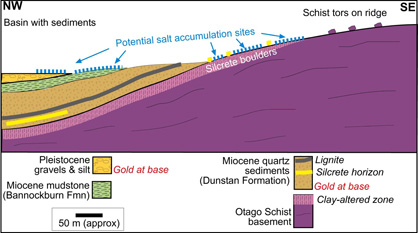
Sketch cross section through the boundary between a typical schist ridge and adjacent sediment-filled basin in Central Otago. Remnants of clay-altered schist occur near this boundary, and this is overlain by Miocene (20-5 million year old) sediments and younger gravels (Pleistocene, less than 1 million years old). Alluvial (placer) gold occurs at the base of quartz conglomerate (Dunstan Formation) and many Pleistocene gravel deposits. Evaporative salts accumulate on impermeable clay-rich surfaces such as exposed clay-altered schist and mudstone of the Bannockburn Formation.
Mudstone deposited in a large inland lake about 10 million years ago is now mapped as the Bannockburn Formation over much of Central Otago, and this is another potential substrate for salt accumulation because of its low permeability. Younger sediments in Central Otago are dominated by gravels that are less than 1 million years old. Most of these gravels are sufficiently permeable to allow rainwater to drain through them, but some contain abundant fine silt, as a matrix and as discrete layers (see photograph below), and these can prevent water flow and encourage salt accumulation. These silt layers were formed by wind transport (loess) and are commonly irregular in thickness and lateral extent.
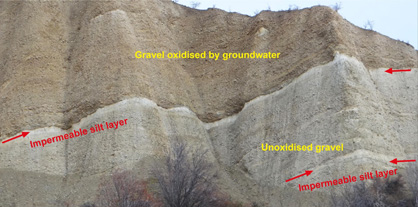
Outcrop of gravel in Central Otago, showing the effect of an impermeable silt layer on water percolation from the surface before erosion exposed this face. The upper part of the outcrop has been oxidised by groundwater infiltration from above, but that water was prevented from going further down by a silt layer (white, red arrows). Below the silt layer, the gravel is less oxidised. The impermeable silts can encourage salt accumulation where they occur near or at the surface.
Salt accumulation enhanced by historic gold mining
In addition to the natural exposures of impermeable substrates during uplift and erosion of the Central Otago area, these same impermeable substrates have been exposed by historic placer (alluvial) gold mining. Historic mining had little or no rehabilitation of sites, so the sites were left just as the miners finished with them. Mining was typically done by sluicing away of overburden with large hose-like devices. The gold occurs in relatively permeable rocks, so the original landscape would have been largely salt-free, and any salts that did occur would have been removed by the sluicing operations. Subsequent changes to the sites over the past 100 years have been minor because of the dry climate. Many of these sites are now preserved for historical reasons, and most of these are accessible to the public.
Two particular sites described below had areas of impermeable substrate exposed by miners in such a way that abundant salts could accumulate over the past 100 years since mining ceased. Salt-tolerant native plants (halophytes) have colonised these substrates from surrounding areas. The high salinity of the substrates prevents incursion of weeds that could otherwise out-compete the halophytes. As a result, some unique halophyte species and ecosystems are preserved at these sites, and the sites have been designated scientific reserves for this reason. The historic mining activity has enhanced the local biodiversity by exposing impermeable substrates that would otherwise have been buried beneath more permeable sediments. Salt accumulation has occurred in these mined areas where it otherwise could not have happened in natural circumstances. The best sites for halophyte colonisation are in small young sediment outwash pans at the feet of outcrops of impermeable rocks that were exposed by the miners. Salts accumulate on the outcrops and wash down to the pans with sediments during vigorous rain events.
1. Chapman Road Scientific Reserve
This reserve (Chapman Road Inland Saline Wetland (ORC website)) is located in a gold mine site in which the gold was found in 10-20 million year old Dunstan Formation quartz conglomerate. The miners sluiced away the quartz conglomerate and some overlying young schist gravels to expose the unconformity between the sediments and the underlying schist bedrock (Waipounamu erosion surface). The layer of clay-altered schist bedrock immediately below the gold-bearing rocks was exposed over large areas by this sluicing (see photograph below). Salts are accumulating on the impermeable clay-altered schist and associated sediment pans in small gullies below the clay outcrops. Similar geology governs similar but smaller saline sites at nearby Flat Top Hill reserve (DOC website).
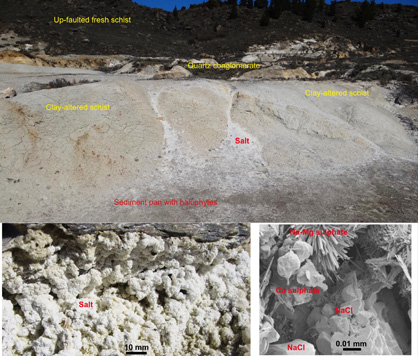
Chapman Road site, showing the clay-rich schist surfaces exposed by historic miners (foreground in top image) as they removed the gold-bearing quartz conglomerate (middle of top image). Mine-related exposure of the impermeable clay rich schist has caused accumulation of evaporative salt derived from marine aerosols in rain, as shown at different scales in the three images. The lower right image is a scanning electron microscope photograph of three different salt minerals: halite (sodium chloride, NaCl), gypsum (Ca sulphate), and bloedite (Na-Mg sulphate).
2. Springvale Scientific Reserve
The Springvale reserve is located in an historic gold mine in which the gold was found near to the base of young (less than 1 million year old) gravels. These gravels rest on mudstone of the 10 million year old Bannockburn Formation, as shown in the upper cross section below. The gold was derived from erosion of nearby uplifted and eroded 20 million year old quartz conglomerates (as at Chapman Road), and this earlier erosion also contributed hard quartz-rich boulders from silcrete horizons in the Dunstan Formation conglomerate (Gold at Alexandra and Ophir). The miners removed the gravel to get at the gold-rich layer at the base, in amongst the quartz-rich boulders. When they had finished, the miners left a large area of mudstone exposed, with some small remnants of gravel and scattered quartz-rich boulders, as shown in the lower cross section below.
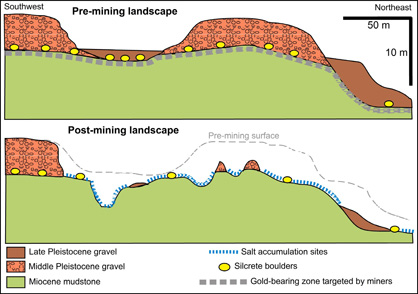
Cross sections through the Springvale site, showing the original gravel cover and topographic surface (top) and the present situation with the gold-bearing gravel removed and the mudstone exposed. The exposed mudstone surfaces accumulate evaporative salts from marine aerosols in rain, which were rare or absent on the gravels before mining of the site.
Since mining ceased, salts have accumulated on the impermeable mudstone surfaces, and these are particularly apparent after rain events, as shown in the images below. The miners left some steep-sided outcrops and gullies cut into the mudstone, and these regulalrly eroding with each significant rain event. The erosion of the outcrops has formed sediment outwash pans below the outcrops, and these pans are saline as well, from downward washing of the salts from the outcrops. The sediment pans are the best sites for colonisation of the halophyte plants, and few halophytes have colonised the crumbling and friable mudstone outcrops themselves.
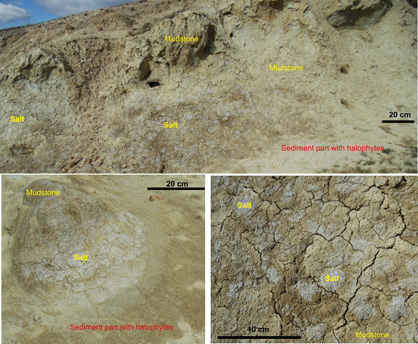
Salt encrustations (white) coat the surface of mudstone outcrops left by historic miners at Springvale. Sediment washed off these outcrops form pans at the base of the outcrops after rain events, and these sediment pans also receive salts washed off the outcrops. Halophyte plants readily grow on the sediment pans but not on the crumbling mudstone outcrops. The high salinity of sediment pans excludes exotic weeds.
Dynamic environmental controls on salt accumulation
The sites of salt accumulation are dynamic environments which are constantly changing. On long time scales (100-1000 years), the uplift and erosion of the schist ridges causes the position of impermeable substrates to migrate laterally, generally downslope. These changes are largely imperceptible at human time scales, although major rain events can cause major reconfiguration of some sites.
Anthropogenic sites such as historic mines have steeper relief locally, and the rates of erosion are faster than on natural slopes. The sediment pans are the most effective low-relief repositories of salts, and for colonisation of halophytes. However, these sites are subject to constant change on a monthly or annual basis. In the photographs below, halophytes are established after about one year of stability on a sediment pan at the Springvale reserve (upper photograph). Nearby, a single rain event has almost buried the halophytes (lower photograph).
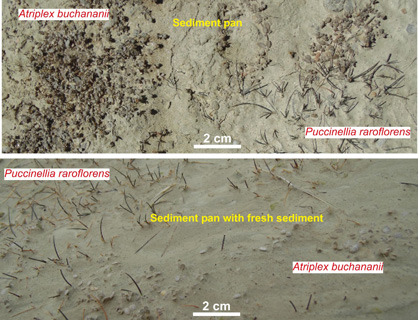
The salt-tolerant halophyte plants grow best in muddy sediment pans that are washed off the surface of the mudstone outcrops at Springvale during rain events. The upper image shows two plant species growing in a young sediment pan immediately below a mudstone outcrop formed by historic mining activity. The lower image shows the same species almost completely buried by mudstone washed down on to a sediment pan during a rain event that occurred a day earlier.
In more detail, the dynamic nature of the salt accumulations is readily apparent on the impermeable surface of the mudstone at Springvale, as shown in the images below. The salt coatings on the surface have developed after a significant rain event. This salt accumulation has trapped an insect during evaporation and salt crystallisation (right image). Salt crystals form readily, but also redissolve readily, as indicated in the lower left image. These changes can happen on time scales of hours or days.
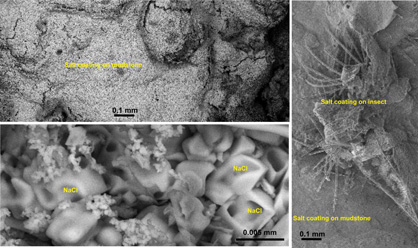
Scanning electron microscope images of salt coatings on mudstone at Springvale. The image at top left shows a thin coating of fine crystals. The image on the right shows a similar coating which has trapped an insect on the mudstone surface. The image at bottom left shows the fine crystals of sodium chloride salt (NaCl) in detail. Some of the cubic NaCl crystals have been partially redissolved, leaving hollow centres.
Additional information
- Chamberlain, C.P.; Poage, M.A.; Craw, D.; Reynolds, R.C. 1999. Topographic development of the Southern Alps recorded by the isotopic composition of authigenic clay minerals, South Island, New Zealand. Chemical Geology 155: 279-294.
- Craw D, Druzbicka J, Rufaut C, Waters J 2013. Geological controls on paleo-environmental change in a tectonic rain shadow, southern New Zealand. Palaeogeography, Palaeoclimatology, Palaeoecology 370: 103-116
- Druzbicka J, Craw D 2012. Turbidity development and dissipation in paleoplacer gold deposits, southern New Zealand. Environmental Earth Science 68, 1575-1589.
- Druzbicka J, Rufaut C, Craw D 2015. Evaporative mine water controls on natural revegetation of placer gold mines, southern New Zealand Mine Water and Environment 34: 375-387.
- Law, S, Rufaut, C, Lilly, K, Craw, D 2016. Geology, evaporative salt accumulation, and geoecology at Springvale historic gold mine, Central Otago, New Zealand. New Zealand Journal of Geology and Geophysics 59
- Craw, Dave; Rufaut, Cathy. 2021. "Geoecological Zonation of Revegetation Enhances Biodiversity at Historic Mine Sites, Southern New Zealand" Minerals 11, no. 2: 181. https://www.mdpi.com/2075-163X/11/2/181